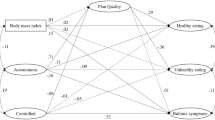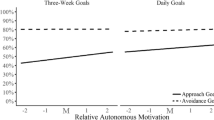Abstract
In 3 studies, the authors examined how autonomous and controlled forms of motivation for the regulation of eating behaviors were related to self-reported eating behaviors, and sustained dietary behavior change. Studies 1 and 2 supported the factorial structure and the psychometric properties of a scale designed to measure different forms of regulation as defined by Self-Determination Theory. A motivational model of the regulation of eating behaviors suggested that an autonomous regulation was positively associated with healthy eating behaviors whereas a controlled regulation was positively associated with dysfunctional eating behaviors and negatively associated with healthy eating behaviors. In Study 3, long-term adherence to healthier dietary behaviors in a population at risk for coronary artery disease was examined over a 26-week period. A general measure of self-determined motivation assessed at week 1 was found to be a reliable predictor of the level of self-determination for eating behaviors 13 weeks later. In turn, self-determination for eating behaviors was a significant predictor of dietary behavior changes at 26 weeks. Finally, the dietary behavior measures were related to improvements in weight and blood lipid parameters (LDL-cholesterol, HDL-cholesterol, triglycerides). Results are discussed in terms of their implication for the integration and maintenance of a successful healthy regulation.
Similar content being viewed by others
REFERENCES
Ajzen, I., & Fishbein, M. (1980). Understanding attitudes and predicting social behavior.Englewood Cliffs, NJ: Prentice-Hall.
American Psychiatric Association. (1994). Diagnostic and statistical manual of mental disorders (4th ed.). Washington, DC: Author.
Bandura, A. (1986). Social foundations of thought and action: A social cognitive theory. Upper Saddle River, NJ: Prentice-Hall, xiii, 617 pp.
Baumeister, R. F., Heatherton, T. F., & Tice, D. M. (1994). Losing control: How and why people fail at self-regulation. San Diego, CA: Academic Press.
Bentler, P. M. (1990). Comparative fit indices in structural models. Psychological Bulletin, 107,238–246.
Blais, M. R., Sabourin, S., Boucher, C., & Vallerand, R. J. (1990). Toward a motivational model of couple happiness. Journal of Personality and Social Psychology, 59,1021–1031.
Bollen, K. A. (1989). Structural equations with latent variables. New York: Wiley.
Bristol, D. R. (1989). Designing clinical trials for two-sided multiple comparisons with a control. Controlled Clinical Trials, 10,142–152.
Byrne, B. M. (1994). Structural equation modeling with EQS and EQS/Windows. Basic concepts, applications, and programming. Thousand Oaks, CA: Sage.
Cataldo, C. B., DeBruyne, L. K., & Whitney, E. N. (1995). Nutrition and diet therapy (4th ed.). St. Paul, MN: West.
Cogan, J. C., & Rothblum, E. D. (1993). Outcomes of weight-loss programs. Genetic, Social, and General Psychology Monographs, 118,385–415.
Deci, E. L. (1975). Intrinsic motivation. New York: Plenum Press.
Deci, E. L., Eghari, H., Patrick, B. C., & Leone, D. R. (1994). Facilitating internalization: The selfdetermination theory perspective. Journal of Personality, 62,118–142.
Deci, E. L., & Ryan, R. M. (1985). Intrinsic motivation and self-determination in human behavior. New York: Plenum Press.
Deci, E. L., & Ryan, R. M. (1987). The support of autonomy and the control of behavior. Journal of Personality and Social Psychology, 53,1024–1037.
Deci, E. L., & Ryan, R. M. (1991). A motivational approach to self: Integration in personality. In R. Dienstbier (Ed.), Nebraska symposium on motivation: Perspectives on motivation (Vol. 38, pp. 237–288). Lincoln: University of Nebraska Press.
Deci, E. L., & Ryan, R. M. (2000). The "what" and "why" of goal pursuits: Human needs and the self-determination of behavior. Psychological Inquiry, 11,227–268.
Diener, E., Emmons, R. A., Larsen, R. J., & Griffen, S. (1985). The satisfaction with life scale. Journal of Personality and Assessment, 49,71–76.
Elliot, A. J., & Sheldon, K. M. (1998). Avoidance of personal goals and the personality-illness relationship. Journal of Personality and Social Psychology, 75,1282–1299.
Elmer, P., Grimm, R., Flack, J., & Laing, B. (1991). Dietary sodium reduction for hypertension prevention and treatment. Hypertension, 17,1182–1189.
Fodor, J. G., Frohlich, J. J., Genest, J. J., Jr., & McPherson, P. R. (2000). Recommendations for the management and treatment of dyslipidemia. Report of the Working Group on Hypercholesterolemia and Other Dyslipidemias. Canadian Medical Association Journal, 162,1441–1447.
Garner, D. M., & Wooley, S. C. (1991). Confronting the failure of behavioral and dietary treatments for obesity. Clinical Psychology Review, 11,729–780.
Glanz, K., Kristal, A. R., Sorenson, G., Palombo, M. S., Heimendinger, J., & Probart, C. (1993). Development and validation of measures of psychosocial factors influencing fat-and fiber-related dietary behavior. Preventative Medicine, 22,373–387.
Green-Demers, I., Pelletier, L. G., & Menard, S. (1997). The impact of behavioural difficulty on the salience of the association between self-determined motivation and environmental behaviours. Canadian Journal of Behavioural Science, 29,157–166.
Guttman, L. (1954). A new approach to factor analysis: The radex. In P. Lazarfel (Ed.), Mathematical thinking in the social sciences (pp. 258–348). New York: Free Press of Glencoe.
Health and Welfare Canada. (1992). Canada's Food Guide to Healthy Eating: Its Rational[Brochure]. Ottawa, ON: Minister of Supply and Services Canada.
Heatherton, T. F. (1993). Body dissatisfaction, self-focus, and dieting status, and dieting status among women. Psychology of Addictive Behaviors, 7,225–231.
Jöreskog, K. G., & Sörbom, D. (1996). Lisrel 8.0: User's reference guide. Chicago: Scientific Software International.
Kristal, A. R., Patterson, R. E., Glanz, K., Heimendinger, J., Hebert, J. R., Feng, Z., et al. (1995). Psychosocial correlates of healthful diets: Baseline results form the Working Well study. Preventative Medicine, 24,221–228.
Kuczmarski, R. J., Flegal, K. M., Campbell, S. M., & Johnson, C. L. (1994). Increasing prevalence of overweight among US adults: The National Health and Nutrition Examination Surveys, 1960 to 1991. JAMA, 272,205–211.
McCann, B. S., & Bovbjerg, V. E. (1998). Promoting dietary change. In S. A. Shumaker, E. B. Schron, J. K. Ockene, & W. L. McBee (Eds.), The handbook of health behavior change (2nd ed., pp. 166–188). New York: Springer.
Patterson, R. E., Kristal, A. R., & White, E. (1996). Do beliefs, knowledge, and perceived norms about diet and cancer predict dietary change? American Journal of Public Health, 86,1394–1500.
Pelletier, L. G. (2002). A motivational analysis of self-determination for pro-environmental behaviors. In E. L. Deci & R.M. Ryan (Eds.), The handbook of self-determination. (pp. 205–232) Rochester, NY: University of Rochester Press.
Pelletier, L. G., Fortier, M., Vallerand, R. J., Tuson, K. M., Brière, N. M., & Blais, M. R. (1995). The Sports Motivation Scale (SMS): A measure of intrinsic motivation, extrinsic motivation, and amotivation in sports. Journal of Sport and Exercise, 17,35–53.
Pelletier, L. G., Sharp, E. C., Blanchard, C. M., Otis, N., Lévesque, C., & Amyot, C. (2004). The General Self-Determination Scale (SMS): Its validity and usefulness in predicting success and failure at self-regulation. Manuscript submitted for publication, University of Ottawa.
Prochaska, J. O., DiClemente, C. C., & Norcross, J. C. (1992). In search of how people change: Applications to addictive behaviors.
Radloff, L. S. (1977). The CES-D scale: A self-report depression scale for research in the general population. Applied Psychological Measurement, 1,385–401.
Rosenbaum, M. (1993). The three functions of self-control behaviour: Regressive, reformative and experiential. Work and Stress, 7,33–46.
Rosenberg, M. (1965). Society and the adolescent self-image. Princeton, NJ: Princeton University Press.
Ryan, R. M., & Connell, J. R. (1989). Perceived locus of causality and internalization: Examining reasons for acting in two domains. Journal of Personality and Social Psychology, 57,749–761.
Ryan, R.M., & Deci, E. L. (2000). Self-determination theory and the facilitation of intrinsic motivation, social development, and well-being. American Psychologist, 55,68–78.
Ryan, R. M., Plant, R. W., & O'Malley, S. (1995). Initial motivations for alcohol treatment: Relations with patient characteristics, treatment involvement, and dropout. Addictive Behaviours, 20,279–297.
Ryan, R. M., Sheldon, K. M., Kasser, T., & Deci, E. L. (1996). All goals are not created equal: An organismic perspective on the nature of goals and their regulation. In P. M. Gollwitzer & J. A. Bargh (Eds.), The psychology of action: Linking cognition and motivation to behavior (pp. 7–26). New York: Guilford Press.
Sheldon, K. M., & Elliott, A. J. (1998). Not all personal goals are personal: Comparing autonomous and controlled reasons for goals as predictors of effort and attainment. Personality and Social Psychology Bulletin, 24,546–557.
Sheldon, K. M., & Kasser, T. (1995).Coherence and congruence: Two aspects of personality integration. Journal of Personality and Social Psychology, 68,531–543.
Steiger, J. H. (1990). Structural model evaluation and modification: An interval estimation approach. Multivariate Behavioral Research, 25,173–180.
Tabachnick, B. G., & Fidell, L. S. (1996). Using multivariate statistics. New York: Harper Collins College.
Thelen, M., Farmer, J., Wonderlich, S., & Smith, M. (1991). A revision of the Bulimia Test: The BULIT-R. Psychological Assessment, 3,119–124.
Vallerand, R. J. (1997). Toward a hierarchical model of intrinsic and extrinsic motivation. In M. P. Zanna (Ed.), Advances in experimental social psychology (Vol. 29, pp. 271–360). New York: Academic Press.
Vallerand, R. J., & Reid, G. (1988). On the relative effects of positive and negative verbal feedback on males' and females' intrinsic motivation. Canadian Journal of Behavioural Science, 20,239–250.
VanIttalie, T. B., & Lew, E. A. (1992). Assessment of morbidity and mortality risk in the overweight patient. In T. A. Wadden & T. B. VanIttalie (Eds.), Treatment of the seriously obese patient (pp. 3–32). New York: Guilford Press.
Wadden, T. A. (1993). Treatment of obesity by moderate and severe caloric restriction. Results of clinical research trials. Annals of Internal Medicine, 119,688–693.
Williams, G. C., Grow, V. M., Freedman, Z., Ryan, R. M., & Deci, E. L. (1996). Motivational predictors of weight loss and weight-loss maintenance. Journal of Personality and Social Psychology, 70,115–126.
Zinder-Wernet, P., & Weiss, S. J. (1987). Health locus of control and preventive health behavior. West Journal of Nursing Research, 9,160–179.
Rights and permissions
About this article
Cite this article
Pelletier, L.G., Dion, S.C., Slovinec-D'Angelo, M. et al. Why Do You Regulate What You Eat? Relationships Between Forms of Regulation, Eating Behaviors, Sustained Dietary Behavior Change, and Psychological Adjustment. Motivation and Emotion 28, 245–277 (2004). https://doi.org/10.1023/B:MOEM.0000040154.40922.14
Issue Date:
DOI: https://doi.org/10.1023/B:MOEM.0000040154.40922.14




